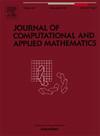具有一般非线性势的时间分数阶Allen-Cahn方程变步长L2-1σ格式的能量耗散和最大界原理
IF 2.6
2区 数学
Q1 MATHEMATICS, APPLIED
Journal of Computational and Applied Mathematics
Pub Date : 2025-09-15
DOI:10.1016/j.cam.2025.117054
引用次数: 0
摘要
本文研究了具有一般非线性势的时间分数阶Allen-Cahn方程既保持能量耗散规律又保持最大界原理的数值格式。我们提出了一种稳定的线性迭代方法,使用变步长L2-1σ公式对Caputo分数阶导数进行时间离散化,使用中心有限差分方法对空间拉普拉斯算子进行离散化。此外,采用梯度网格来解决初始奇异性问题,采用自适应策略来捕获多尺度行为。该方法在离散环境下保持了能量耗散规律和最大界原理。利用数值解的最大有界性,利用离散分数阶Gönwall不等式,导出了该格式的L∞范数误差估计。最后,我们提供了大量的数值结果来验证所提出方案的理论结果和计算效率。本文章由计算机程序翻译,如有差异,请以英文原文为准。
Energy dissipation and maximum-bound principle of the variable-step L2-1σ scheme for the time-fractional Allen–Cahn equation with general nonlinear potential
In this study, we focus on a numerical scheme that maintains both the energy-dissipation law and the maximum-bound principle for the time-fractional Allen–Cahn equation with a general nonlinear potential. We propose a stabilized linear iterative method, using the variable-step L2- formula for the discretization of the Caputo fractional derivative in time and the central finite difference method for the spatial Laplacian. Furthermore, graded meshes are utilized to address the initial singularity and adaptive strategies are used to capture multiscale behavior. The proposed method is demonstrated to preserve the energy-dissipation law and maximum-bound principle in discrete settings. With the help of the maximum boundedness of the numerical solution, we derive the -norm error estimate of the proposed scheme by using the discrete fractional Gönwall inequality. Finally, we provide extensive numerical results to verify the theoretical results and computational efficiency of the proposed scheme.
求助全文
通过发布文献求助,成功后即可免费获取论文全文。
去求助
来源期刊
CiteScore
5.40
自引率
4.20%
发文量
437
审稿时长
3.0 months
期刊介绍:
The Journal of Computational and Applied Mathematics publishes original papers of high scientific value in all areas of computational and applied mathematics. The main interest of the Journal is in papers that describe and analyze new computational techniques for solving scientific or engineering problems. Also the improved analysis, including the effectiveness and applicability, of existing methods and algorithms is of importance. The computational efficiency (e.g. the convergence, stability, accuracy, ...) should be proved and illustrated by nontrivial numerical examples. Papers describing only variants of existing methods, without adding significant new computational properties are not of interest.
The audience consists of: applied mathematicians, numerical analysts, computational scientists and engineers.

 求助内容:
求助内容: 应助结果提醒方式:
应助结果提醒方式:


